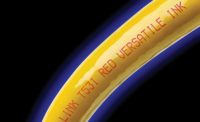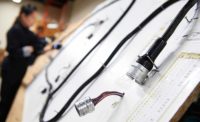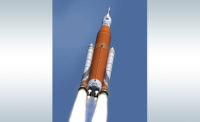There are many ways to mark wire and cable.
Labels are simple and economical, and they can accommodate a lot of information. However, labels can be labor-intensive to apply, and they take up space. They’re also susceptible to damage.
Like labels, heat shrink tubing can be printed with text and graphics—and they provide the additional benefit of environmental and electrical protection. On the other hand, heat shrink tubing is expensive, and it, too, can be labor-intensive to apply.
Hot stamp marking produces durable and legible markings on soft and hard insulation materials. However, it’s slow and inflexible. And, because it creates an embossed imprint, hot stamping could adversely affect the integrity of thin insulation.
Laser marking is fast and flexible, and it produces durable marks on a range of insulation materials. On the down side, laser marking equipment is very expensive.
Ink-jet printing offers many of the advantages of these other methods, but few of their limitations. This noncontact method is fast, flexible, inexpensive and easy to maintain. Ink-jet printers can be integrated before or after automatic cutting and stripping equipment for continuous production. Printing takes place on the fly—that is, while the wire or cable is moving—and can be done on most insulation materials.
In some cases, ink-jet printing may be the only way to mark certain wires. For example, laser marking is not an option for military-grade wire and cable insulated with ethylene tetrafluoroethylene (ETFE), a fluorine-based plastic. But, a UV-curing ink applied with a continuous ink-jet printer can do the job.
Partnerships between manufacturers of cutting and stripping machines and ink-jet printers have allowed the development of closed-loop wire marking systems with plug-and-play connections. Ink-jet printers can be programmed and run through the same software that governs the rest of the wire processing line, which simplifies setup and changeover.
How It Works
Continuous ink-jet systems work by expelling electrically charged ink droplets from a printhead and passing them through an electric field.
Tiny droplets—half the diameter of a human hair—are created inside the printhead by a pulsing piezoelectric crystal. The droplets are charged by an electrode as they break off from the ink-jet. (The printer recirculates any ink droplets that don’t get charged, so ink is not wasted.) The charged droplets then pass through an electrostatic field between deflector plates. The combination of the speed and charge determines the position of the droplet on the substrate.
“Continuous ink-jet printers for wire marking are a totally different animal than the ink-jet printer in your home office,” says Huck Hyde, service and R&D specialist at Gem Gravure Co. Inc. “The piezoelectric crystal is vibrating at a rate of 64 to 126 kilohertz, so up to 126,000 of these tiny droplets are expelled every second. You can reach print speeds of about 1,500 feet of wire per minute.”
Ink-jet printers can mark wire with alphanumeric text, serial numbers, symbols, patterns and bar codes. Depending on the size of the wire, ink-jet printers can print multiple lines of text or even Data Matrix codes, simple graphics and logos. It’s also possible to print on uneven surfaces, such as twisted wire.
“We can print on wire as small as 26 or even 28 gauge,” says Hyde.
Many ink-jet printers have features, such as gutter sensors, nozzle unclogging and automatic flushing, that reduce the possibility of ink spillage caused by nozzle clogs.
A wide range of inks is available to use with ink-jet printers. The most common inks consist of a dye or pigment dissolved in a solvent, such as methylethylketone (MEK) or alcohol. The former can pose a health concern, but the latter takes longer to dry.
“Pigmented inks have particles in them that provide color and opacity,” says Hyde. “They will cover up whatever they’re sitting on. Dye-based ink can let the substrate show through. Dye-based inks are easier to run. The color stays suspended. With pigmented inks, the color particles can settle.”
The most common and economical ink for marking wire is black, dye-based ink. It’s inexpensive and less prone to clogging. For printing on dark substrates, pigment-based inks are available in contrasting colors, such as white or light blue.
UV-curing inks are another option for printing on wire. These inks don’t rely on solvent evaporation for curing. Rather, they cure instantly when exposed to UV light. “When these inks are exposed to UV light, they cross-link with the substrate. At that point, they’re impervious to just about anything. You can expose it to solvents or gasoline and the ink won’t come off the substrate,” explains Hyde.
New Printers
One of the newer ink-jet printers on the market is the ims 295 series from Komax. The printer is equipped with RS-232 and Ethernet interfaces, so it can be operated in conjunction with current and future Komax cutting, stripping and crimping equipment.
Like other Komax wire processing equipment, the printer is programmed through the company’s TopWin or KappaWin software. Text input, setup parameters and other settings are entered from a user-friendly interface. Information can be printed at either end of a wire, in the middle of a wire, or the entire length of a wire. Standard functions include bold text, symbols, adjustable font width and height, double character spacing, inverse font and continuously alternating text.
The device can print on wire as small as 1.2 millimeters in diameter. Maximum print speed is 26.5 feet per second. Font height ranges from 1 to 4.5 millimeters. The ink tank can store 1.25 liters of non-pigmented or lightly pigmented ink.
Ink density is measured constantly with an automatic solvent metering unit to ensure operation that is both economical and environmentally safe. A condenser unit is available as an option to recover solvent. It reduces solvent consumption and virtually eliminates the presence of solvent from the air in the room.
The ink and solvent tanks are easy to access. Inks can be replenished while marking is occurring.
Ink pressure is built up automatically with a gear pump. There’s no need for compressed air. A speed optimization feature ensures that wire sections without marking are processed at the maximum possible speed.
The M-100J fully automatic ink-jet system from Tri-Star Industries includes an in-line plasma pretreatment system and in-line UV curing system. Plasma treatment enhances the quality and durability of the mark, and it enables the device to print on almost any wire insulation material, including fluropolymers, such as Tefzel and Teflon. UV curing ensures that ink bonds instantly to the substrate. No additional waiting or curing time is necessary.
This computer-controlled machine can print on wire and cable at a rate of 600 feet per minute. The system accommodates both round and twisted wire and cable ranging from 0.038 to 0.25 inch in diameter. The system is meets MIL-W-5088L and MIL-M-81531 standards and is Boeing-certified.
Ink-Jet Printers Speed Production at Contract Assembler
Located in Lugoj, Romania, LC Electronic SRL manufactures cable assemblies, power distribution modules and other electrical and electronic subassemblies. The company was founded in 1994 with six employees. Today, LC Electronic employs 200 people and has more than 35,000 square feet of manufacturing space.
LC Electronic primarily processes PVC-jacketed cables ranging from 3 to 20 millimeters in diameter. Recently, the company replaced its old cable printing equipment with the alphaJET series of continuous ink-jet printers from KBA-Metronic GmbH. Each printer is located between a cable reel and a Kappa automatic cutting and stripping machine from Komax. This saves space and speeds production.
The printers integrate seamlessly with Komax’s TopWin control software, so the entire wire processing line can be set up and controlled with a common platform. LC Electronic’s engineers use TopWin to create text lists with details of print layout, content and positioning. A user-friendly, color touch screen display facilitates data entry.
The alphaJET ink-jet printers can accommodate both pigmented and dye-based inks. All but one of LC Electronic’s printers is supplied with black ink. The one exception runs white ink, which provides better contrast on dark-colored insulation. The printers accept 1-liter bottles of ink and solvent. An integrated solvent recovery system conserves materials and minimizes odors. Compressed air is not required for printing.
The alphaJET can print multiple lines of text, depending on the font size and the cable thickness. Text height ranges from 0.8 to 15 millimeters. The machine can also print logos, bar codes and Data Matrix codes. Maximum print speed is 460 meters per minute. The printer can automatically generate serial numbers and time and date codes. Integrated distance measurement ensures accurate placement of text and graphics on the wire.
The printer has a stainless steel housing and carries an IP 65 protection rating. The printer is equipped with USB, Ethernet and RS-232 ports, as well as a digital I/O port with eight inputs und four outputs.
In the U.S., alphaJET printers are available through Gem Gravure. For more information, call 781-878-0456 or visit www.gemgravure.com.







